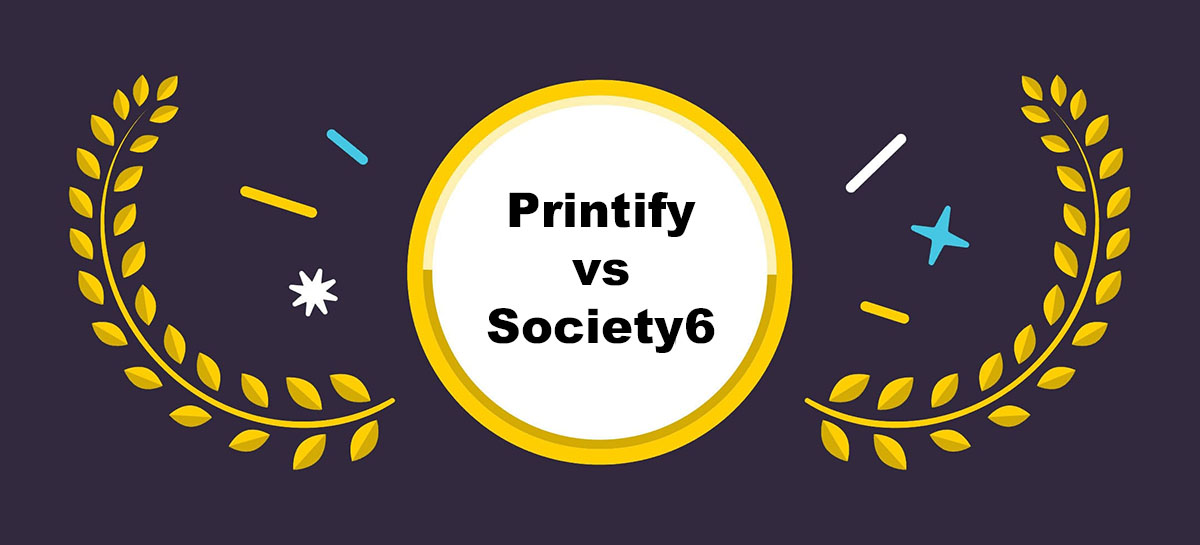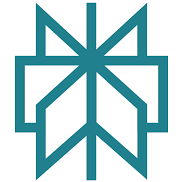If you’re trying to pick between Printify and Society6, here’s the short answer:
Printify is best for ecommerce sellers who want control, higher profits, and the ability to scale fast. Society6 is better if you’re an artist looking for exposure and passive income with minimal setup.
After years of hands-on experience using both to launch and grow multiple POD stores, I can confidently say that Printify is the stronger choice if you want to build a scalable print on demand business with full control.
In this detailed comparison, I’ll break down where each platform shines — from pricing and product control to integrations, marketing tools, and ease of use.
Whether you’re just starting out or already running a creative business, I’ll help you find the best fit for your goals.
Key Takeaways
- Printify gives you full pricing and branding control with over 800 customizable products
- Society6 handles everything for you, but limits your profit margins and customer access
- Printify integrates with Shopify, Etsy, and WooCommerce
- Society6 is a curated marketplace with built-in exposure but no ecommerce flexibility
- Printify is better for business growth, while Society6 suits passive, portfolio-style selling
Quick Comparison: Printify vs Society6
Here’s a clear side-by-side view of what each platform offers at a glance:
| Feature | Printify | Society6 |
|---|---|---|
| Ideal For | Ecommerce sellers | Artists & designers |
| Starting Price | Free ($24.99/mo Premium optional) | Free |
| Product Range | 800+ items | ~60 curated products |
| Branding Control | Full (custom domains, packaging) | None (Society6 branded) |
| Integrations | Shopify, Etsy, WooCommerce | None |
| Customer Ownership | Yes | No |
| Support | Live chat, tutorials | Email support, artist community |
Best for Pricing: Printify Gives You Room to Grow
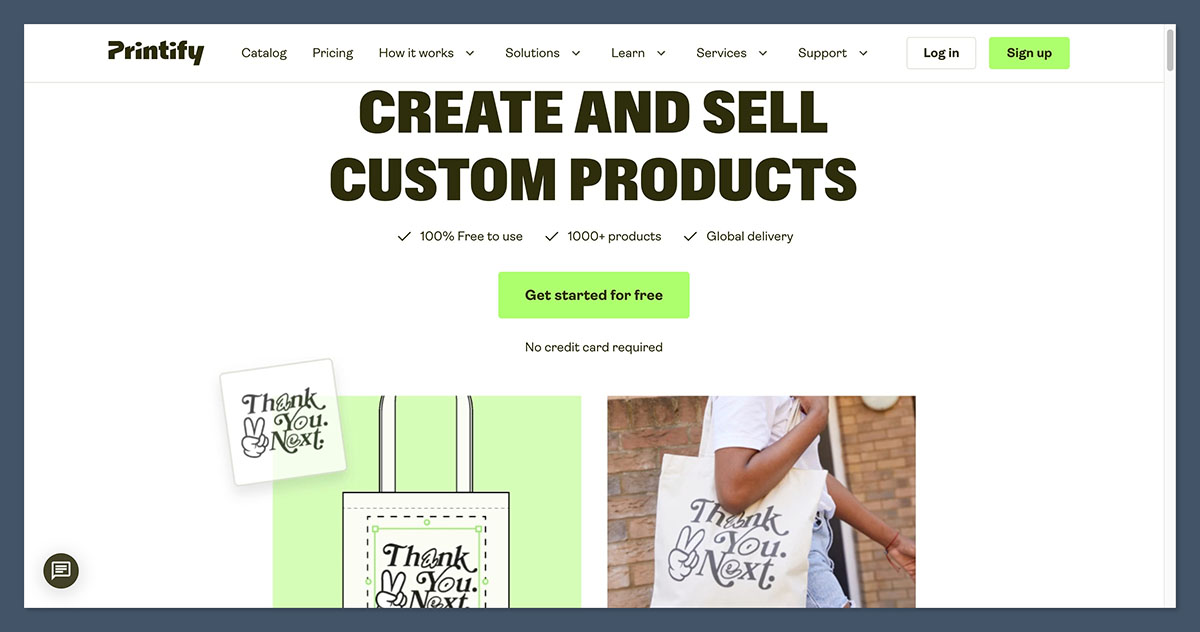
Verdict: Printify offers better pricing flexibility and long-term profit potential.
If you’re trying to build a profitable print-on-demand business, pricing matters more than most creators realise.
I’ve worked with both print on demand platforms — and when it comes to setting margins, testing pricing strategies, and keeping costs predictable, Printify gives you far more control than Society6.
With Printify, your revenue isn’t capped. You’re responsible for setting your prices, adjusting for promotions, and even choosing lower-cost suppliers to increase your profit margins.
That’s a big advantage when scaling.
Printify Pricing Breakdown:
- Free plan: Access to all core features with no monthly fee
- Premium plan: $24.99/month — unlocks up to 20 percent off product base costs
- Retail pricing: You set your own retail prices
- Profit margins: Fully customizable — you can test higher markups and bundle deals
- Discount strategy: Run your own promotions, volume pricing, or sales via your storefront
On the Premium plan, that 20 percent discount can be a game-changer. On popular products like mugs or hoodies, it lets you undercut competitors or simply pocket more profit per sale.
Now, Society6 is simpler, but simplicity comes at a cost — literally.
Society6 Pricing Breakdown:
- No monthly fee: No upfront commitment
- Base prices: Fixed by Society6 — you can’t adjust them
- Markup control: You can only set the markup for a few print-based products
- Other margins: Fixed and pre-set — usually result in very slim profits
- No discounting options: Sales and deals are controlled by Society6
To put it in numbers:
- On Printify, I’ve made anywhere from $15 to $20 per hoodie
- On Society6, profit was often just $2 to $5, even on higher-ticket items
You can’t run ads or offer bundle discounts effectively with fixed profit margins. It leaves you with very little breathing room when it comes to scaling.
Pricing Feature Comparison:
| Feature | Printify | Society6 |
|---|---|---|
| Monthly Fee | Optional ($24.99 Premium) | None |
| Profit Control | Full | Very limited |
| Product Base Costs | Varies by provider | Fixed |
| Discount & Promotions | Yes | No |
| Margin Flexibility | Yes | Limited to art prints |
Takeaway:
If you want to scale a POD business, Printify’s flexible pricing model gives you control, room for profit, and tools to adjust as your store grows.
Society6’s static pricing is fine for passive income but can feel restrictive once you understand what you’re leaving on the table.
Best for Selling Online: Printify Takes the Lead
Verdict: Printify is the clear winner if you want to run your own online store or sell on marketplaces.
Printify is designed to plug directly into your ecommerce machine.
Whether you’re building a custom Shopify store, running an Etsy shop, or using WooCommerce, Printify slides right in and becomes your product backend.
This means you can build a fully branded storefront and own the customer journey end-to-end.
Printify Integrations:
- Shopify: Build your own branded store with full control
- Etsy: List products directly to your Etsy shop
- WooCommerce: Great for WordPress users with ecommerce needs
- eBay (via third-party tools): Reach a different type of customer
- Manual Orders: Useful for bulk orders or offline sales
Once connected, everything syncs automatically. Orders flow from your storefront into Printify, and products ship out without you needing to touch anything.
Now compare that to Society6, which is essentially a closed ecosystem. You upload your artwork, apply it to available products, and they appear on your artist profile within Society6’s marketplace.
There are no integrations, no storefront ownership, and no way to plug Society6 into your own website or brand. You’re selling inside their world — not building your own.
Key Selling Limitations on Society6:
- No integrations with Shopify, WooCommerce, or other platforms
- No access to customer emails or analytics
- No way to retarget visitors or build a loyal buyer base
- No ability to A/B test listings or pages
- No control over how your listings appear or are promoted
Selling Control Comparison:
| Feature | Printify | Society6 |
|---|---|---|
| Shopify Integration | Yes | No |
| Etsy Integration | Yes | No |
| Customer Ownership | Full | None |
| Email Marketing | Yes (via integration) | No |
| Ad Tracking | Yes | No |
| Sales Channels | Unlimited | Society6 only |
The difference really comes down to control vs convenience. If you’re serious about growing a business, not just uploading a few designs, control is everything.
You can set up Facebook and Google ad tracking, retarget abandoned carts, build upsell funnels, and run promotional campaigns — all with Printify.
With Society6, the platform handles everything. You wait for sales. That might sound appealing at first, but the trade-off is that you’re totally dependent on their ecosystem — and their algorithm.
Takeaway:
Printify is a business tool. Society6 is a marketplace.
If you want long-term brand growth, ecommerce integrations, and customer retention, Printify is the smarter play.
Best for Artists: Society6 Makes It Easy
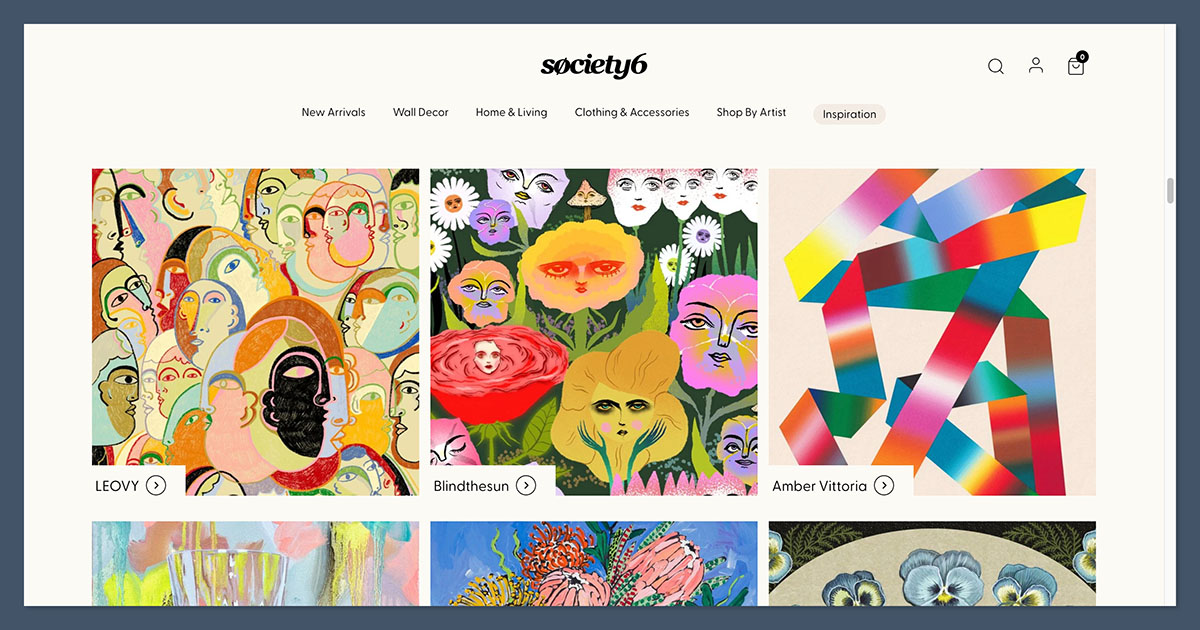
Verdict: Society6 wins if your main goal is to showcase art and make passive income.
If you’re a visual artist, illustrator, or designer who wants to get your work out there without running a full ecommerce business, Society6 is built with you in mind.
I started my journey in POD as a designer, and I get the appeal. Society6 makes things simple.
You upload your artwork, apply it to a curated product list, and let them take it from there. You don’t have to deal with customer support, order issues, or figuring out tax settings.
There’s also a built-in marketplace. Unlike other POD platforms where you have to generate your own traffic from day one, Society6 already has a community of shoppers and collectors browsing for new artwork.
That exposure matters, especially if you’re just getting started.
Getting Started With Society6:
- Create an account
- Upload your designs
- Select the products you want to offer (prints, apparel, decor, etc.)
- Publish and go live
From there, Society6 takes care of:
- Listing your products
- Handling production and packaging
- Shipping to customers globally
- Managing refunds, returns, and customer service
They also feature artists through curated collections, editor picks, and social media highlights — so there’s some marketing potential baked in.
That said, it’s important to understand that you’re contributing to Society6’s brand, not building your own. You won’t get customer data, you can’t retarget past buyers, and you can’t control the user experience.
Artist Experience Breakdown:
| Feature | Printify | Society6 |
|---|---|---|
| Creative Control | Full branding, site design, UX | Limited to artwork uploads only |
| Marketing Support | DIY via storefront | Some built-in exposure + curation |
| Community & Recognition | Minimal, no marketplace exposure | Strong artist community & discovery |
| Passive Income Potential | Moderate (depends on store effort) | High (especially with featured work) |
| Portfolio Showcase | Not built-in | Marketplace artist profile |
If you’re looking for low-maintenance income and care more about exposure than margins, Society6 is a solid choice.
You’re not responsible for driving traffic or building infrastructure — the trade-off is giving up business ownership.
Takeaway:
If you’re a full-time artist or just looking for passive creative income, Society6 offers a straightforward way to get your art in front of buyers.
But if you’re hoping to build a standalone brand, it’s not the right tool for that job.
Product Range and Fulfillment: Printify Has the Edge
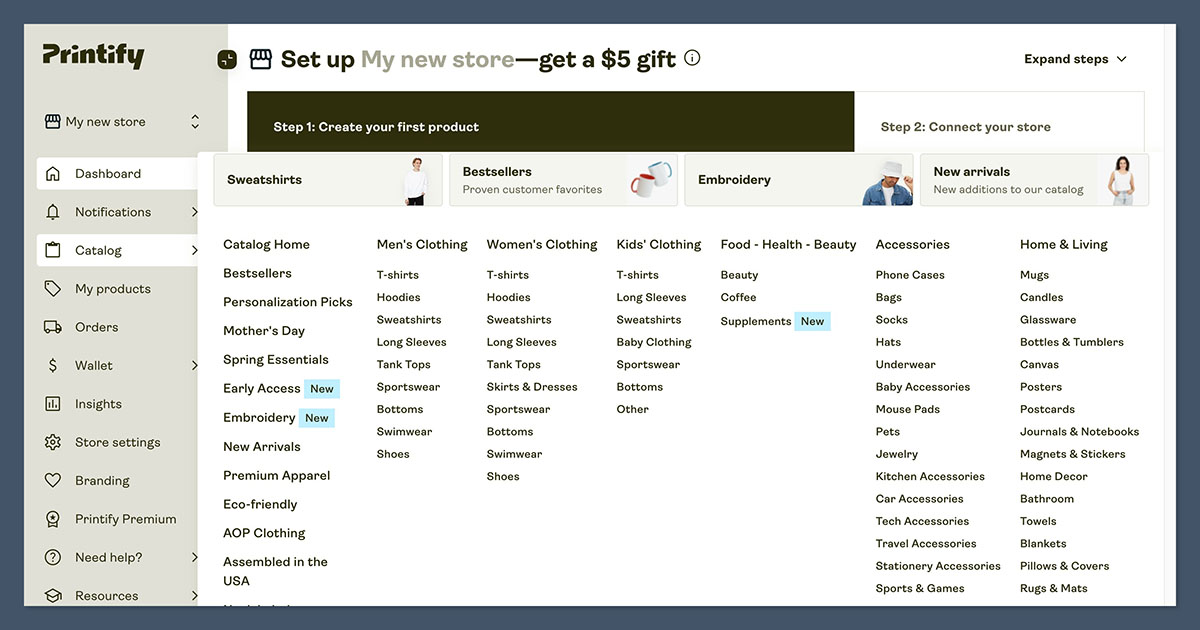
Verdict: Printify wins on variety, shipping options, and control over print quality.
One of the biggest advantages I’ve seen using Printify is the massive product catalog. You’re not limited to a curated list — you can choose from over 800 products from multiple print providers around the world.
Whether you’re selling mugs, pet beds, or yoga mats, the selection is unmatched.
That flexibility lets you test new niches, expand your catalog quickly, and keep your store fresh. It’s a big edge if you want to scale.
Popular Product Types on Printify:
- Apparel: T-shirts, hoodies, crop tops, baby onesies
- Accessories: Tote bags, phone cases, hats, stickers
- Home & Decor: Throw pillows, shower curtains, wall tapestries
- Unique Items: Duffel bags, clocks, bean bags, journals, yoga mats
Each product comes with multiple supplier options, which lets you filter by:
- Geographic location (US, UK, Europe, Canada, etc.)
- Price point (cheaper base cost or premium quality)
- Shipping speed (some offer 2–3 day turnaround)
- Product rating (based on seller reviews and Printify scoring)
You can also enable branded packaging and packing slips with certain providers, which helps when building a recognizable customer experience.
Now compare that to Society6. They offer about 60 products, all handled in-house. Their lineup focuses heavily on art-related merchandise:
- Prints (framed, canvas, metal, etc.)
- Wall art and posters
- Home goods like pillows, curtains, rugs
- Select apparel and tech accessories
While the quality is consistent and professionally produced, there’s no flexibility. You can’t change providers, adjust fulfillment preferences, or speed up delivery.
Fulfillment Comparison:
| Feature | Printify | Society6 |
|---|---|---|
| Product Catalog | 800+ items | Around 60 curated products |
| Shipping Options | Varies by provider | Standard only |
| Fulfillment Providers | Multiple print partners (you choose) | In-house fulfillment only |
| Branded Packaging | Yes (with select providers) | No |
| Control Over Quality | High (by selecting top-rated vendors) | Moderate, fixed process |
When I launched new products with Printify, I could test different suppliers to find the sweet spot between quality and margin. That’s impossible with Society6 — what you see is what you get.
Takeaway:
Printify gives you the tools to scale, customize, and differentiate your brand.
Society6 keeps things simple, but you lose flexibility, margin control, and product variety along the way.
Marketing and Branding: Printify Is Built for Business
Verdict: Printify wins hands down for branding, SEO, and marketing.
This was a big one for me when I started building my own stores. If you care about marketing, lead generation, and creating a brand people remember, Printify gives you full control.
Because Printify integrates with platforms like Etsy and Shopify, you can customise everything about your product listings and how your store appears in search engines.
With Printify, I control:
- SEO-optimised product titles with focus keywords
- Meta descriptions and alt text for images
- Custom product URLs for clean, shareable links
- Email flows to welcome, upsell, or recover abandoned carts
- Pixel tracking for Facebook, Google, TikTok and more
- Upsells and cross-sells on product pages
- User reviews and social proof tools to build trust
Printify isn’t the one doing the marketing—you are. And that’s the point. You own the customer relationship, so you can run paid ads, content marketing, or influencer campaigns to bring traffic back to your store.
With Society6, that’s not the case. You’re one of many artists inside their marketplace.
There’s no customisation of URLs, no SEO settings, and no email list to build. You can’t install analytics or create funnels. You just upload your art and hope it’s discovered.
The platform does handle marketing to some extent—they feature selected artists and run email campaigns to buyers—but it’s entirely out of your control.
Marketing Features Breakdown:
| Feature | Printify | Society6 |
|---|---|---|
| Email Marketing | Yes | No |
| SEO Control | Full | None |
| Branded URLs | Yes | No |
| Product Page Customisation | Yes | No |
| Pixel Tracking | Yes | No |
Takeaway:
If you want to build a real brand with your own voice, store design, SEO strategy, and email marketing, Printify gives you every tool you need.
Society6 limits your role to contributor—great for simplicity, not great for growth.
Ease of Use: Depends on Your Goal
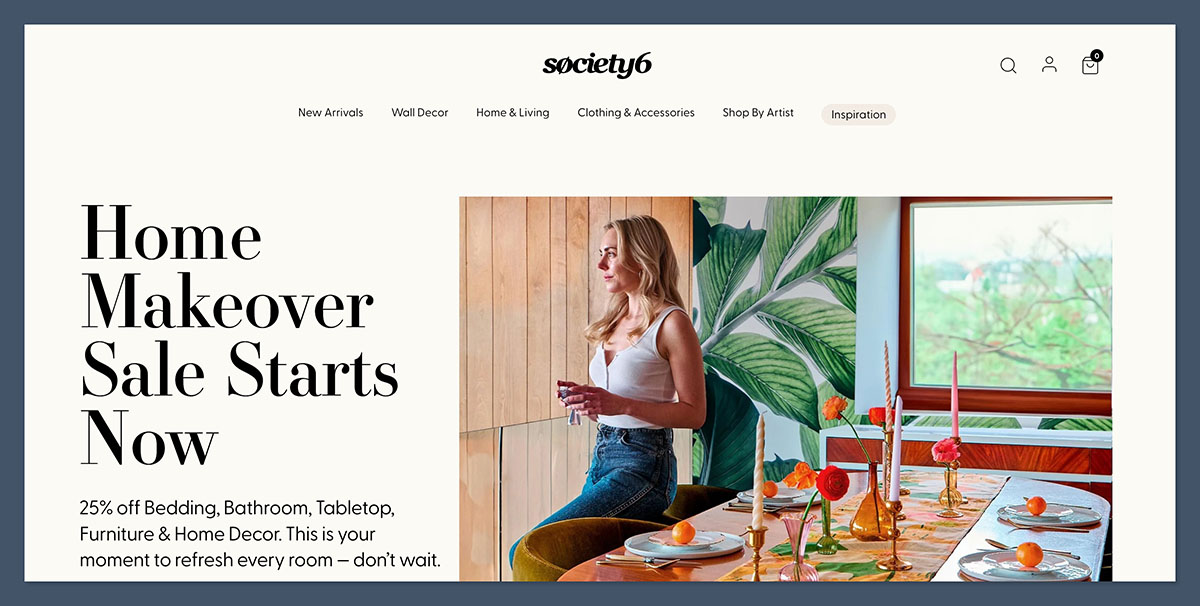
Verdict: Society6 is easier for beginners, but Printify is better once you’re ready to scale.
Ease of use comes down to what you want. If you’re new to print-on-demand or don’t want to learn ecommerce systems, Society6 is the easier place to start.
Getting Started With Society6:
- Sign up with your artist account
- Upload your artwork
- Choose which products to apply it to
- Set your markup for prints (Society6 handles the rest)
It’s quick—most sellers can go live in under 20 minutes. No setup headaches, no integration steps, no decisions about shipping or suppliers.
Printify, on the other hand, has more steps. You’re building an actual ecommerce store—so naturally, there’s more to configure:
What’s Required With Printify:
- Connect to a platform like Shopify or Etsy
- Set up payment gateways (Stripe, PayPal, etc.)
- Choose your print provider per product
- Configure shipping zones and rates
- Optimise product titles, descriptions, and pricing
That learning curve pays off. Once it’s set up, you have way more freedom and scalability.
You can automate marketing, test new SKUs quickly, and use tools like subscription upsells or bundle builders.
Setup Experience:
| Step | Printify | Society6 |
|---|---|---|
| Account Setup | Moderate | Very easy |
| Product Upload | Manual per SKU | Bulk with artwork |
| Order Fulfillment | Automated | Fully automated |
| Custom Domain | Yes | No |
| Store Design | Full control | No control |
Takeaway:
If you want to go live fast with no setup stress, Society6 is the smoothest option.
But if you want to grow a real ecommerce business, Printify gives you the flexibility to do it right.
Support & Community
Verdict: Society6 is more artist-friendly, Printify is more business-focused.
Both platforms offer support, but they serve different purposes and different types of creators.
Printify Support Includes:
- Live chat for real-time seller support
- Extensive knowledge base with articles and guides
- Premium plan access to faster, more responsive support
- Order issue handling through a central dashboard
- Tutorials and templates for setup and product creation
You’re treated like a business owner. Printify’s support is built to help you solve technical issues, fulfilment delays, and storefront challenges.
Society6 Support Includes:
- Email support for artists
- Artist community hub with forums and peer feedback
- Resources on how to get featured
- Artist campaigns and promotions run by Society6’s team
Society6 leans into artist discovery and community. You’ll find a strong network of other creatives, and the chance to be included in featured collections or curated emails.
That exposure can lead to spikes in traffic and sales—if you’re selected.
But the downside? You don’t have full access to solve business problems or tweak backend settings. Support is more about participating, less about optimising.
Support Experience Breakdown:
| Feature | Printify | Society6 |
|---|---|---|
| Real-Time Support | Yes (live chat) | No |
| Help Docs & Tutorials | Extensive | Moderate |
| Artist Community | Limited | Strong |
| Campaign Features | No | Yes (curated exposure) |
| Priority Support (Paid Plan) | Yes | No |
Takeaway:
If you need backend help and business-level support, Printify gives you the infrastructure to run efficiently.
If you’re after a collaborative, creative atmosphere and occasional platform-driven exposure, Society6 delivers on the community side.
Final Verdict: Which Platform Should You Choose?
Here’s the bottom line — your decision should match your goals.
Summary Table:
| Choose This | If You Want… |
|---|---|
| Printify | Full control, high profit margins, ecommerce integrations, brand building |
| Society6 | Easy setup, passive income, artist exposure, and no customer service hassles |
Printify is ideal for sellers who treat POD like a business. You’ll need to put in more work upfront, but you’ll gain total control over your store, margins, and customer experience.
Society6 is perfect for creators who want a more passive experience. You won’t own the customer or the brand, but you’ll still be able to monetise your work with minimal effort.
Final Takeaway:
There’s no one-size-fits-all here.
But based on real use and hands-on results, Printify gives you the tools to build a sustainable, scalable business.
Society6 is a nice side channel for artists — just don’t expect it to replace your full-time income unless you’re heavily featured or go viral.


